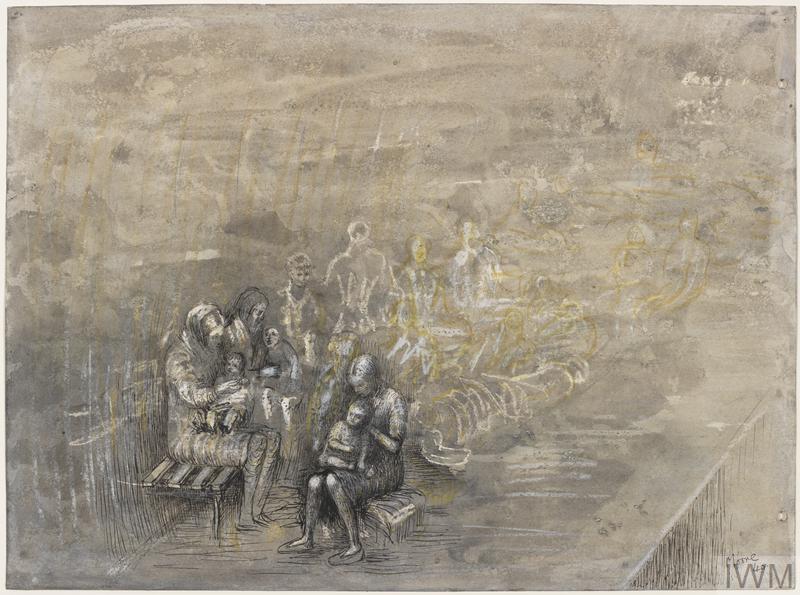Romantic Era Blog
When it comes to the styles of the Romantic Era, I find myself drawn to Romanticism more than anything else. I've always been a fan of works that seek to elicit an emotional response over any sort of pride or merely looking nice. Not that those aren't valid reasons to create, of course, but they don't interest me as much as something designed to make you feel. I also enjoy the variety of techniques and mediums utilized during this period, as can be seen in the works I've chosen for this blog post.
The Sleep of Reason Produces Monsters, Francisco Goya, 1799, Bordeaux, France
Francisco Goya, more well-known for his work The Third of May 1808, also dabbled in prints, such as the one pictured here, The Sleep of Reason Produces Monsters. I adore this etching, particularly for its illustration-esque style. The line-art is amazing, utilizing hatching and curves to give the illusion of a more three-dimensional figure. The composition of the piece draws the eye from the sleeping artist, shone in primarily bright shades, to the owl on his back, of which the wings drag the eye upwards further to the bats flying around him. Hidden in the center of the piece, a creature with dark fur and gleaming eyes hides, the contrast between its sclera and face making its gaze seem piercing and sharp. It creates a feeling of slow-building dread the more details you notice. I'm rather biased in picking this piece for Goya, as I myself prefer illustrative styles, but the details in the shading and textures of this piece inspire me to better my own line-work.
Wanderer Above the Sea of Fog, Caspar Friedrich, 1818, Hamburg, Germany
Caspar Friedrich was a Romantic artist from Germany who primarily painted landscapes. His work Wanderer Above the Sea of Fog is a beautiful and melancholic piece which I greatly enjoy. As opposed to Goya's print shown earlier, Friedrich's painting uses smooth brushstrokes and rich colour to create emotion. The high contrast between the dark foreground elements and the lighter midground and background provides a sharp, bold silhouette that catches the eye. The pose is just dynamic enough to bring a sense of stoic life to the image, and the waves have an obviously soft texture to them to depict the ocean foam. There is debate over whether the figure in the painting is meant to be Friedrich himself, or a high-ranking forestry officer under the employ of King Friedrich Wilhelm III. Depending on which one you view it as actually changes the mood of the painting; if it's a self-portrait, it has a somber sort of reflection to it, whereas if it's the officer, there is a feeling of inherent loss for a man who very likely died prior to this painting's existence.
Now, while I don't necessarily hate or even dislike impressionism, I don't find myself as fond of it as I do Romanticism. The blurred lines and vague shapes tend to strain my eyes, and I find myself less attached or driven by much of the art in this style.
The Dance Class, Edgar Degas, 1874, Paris, France
Edgar Degas, who was born and died in Paris, France, was an Impressionist artist who didn't refer to himself as such, instead choosing the titles of Realist or Independent. According to Ruth Schenkel in her essay on the painter, "Like the Impressionists, he sought to capture fleeting moments in the flow of modern life, yet he showed little interest in plein-air landscapes, favouring scenes in theatres and cafes illuminated by artificial light". While his technique and style is definitely impressive, and his composition does a good job guiding the eye throughout the piece, I find the contrast lacking. The ribbons on the dancers in the midground of the painting are slightly more high-lighted than the rest of the work, but the rest of the colours seem to meld into the same tone. That combined with the blurry brushstrokes and lack of sharp lines makes it hard for me to look at this painting for too long without feeling pressure build up in my eyes.
Robert Louis Stevenson, John Sargent, 1887, London, England
John Sargent was born in Florence, Italy to American parents, and traveled to Paris and then England as he continued his artistic career. Again. I have a bit of a positive bias towards this piece despite being done in a style I don't entirely enjoy, as the subject is the author of my favourite novella. Unfortunately, despite this fact, I once again find it hard to look at this painting for too long without receiving a headache. Even more-so than the previous Impressionist piece, the brushstrokes blend together in an almost muddy blur, confusing my eyes as they drift across the piece. In my opinion, Stevenson's hands and face don't match the style of the rest of the painting, contrasting a bit too sharply. The composition feels a bit squashed, with the subject's torso appearing shorter than it should. Overall, this piece isn't to my personal tastes, and it causes me a bit of pain to look at for extended periods of time, similar to attempting to read print in a moving vehicle.
Information sourced from:
Francisco Goya: https://www.theartstory.org/artist/goya-francisco/
Caspar Friedrich: https://www.artble.com/artists/caspar_david_friedrich/paintings/wanderer_above_the_sea_of_fog
Edgar Degas: https://www.metmuseum.org/toah/hd/dgsp/hd_dgsp.htm
John Sargent: https://www.johnsingersargent.org/biography.html







Comments
Post a Comment